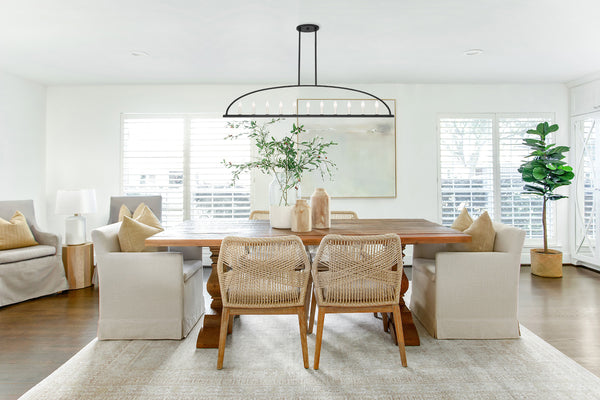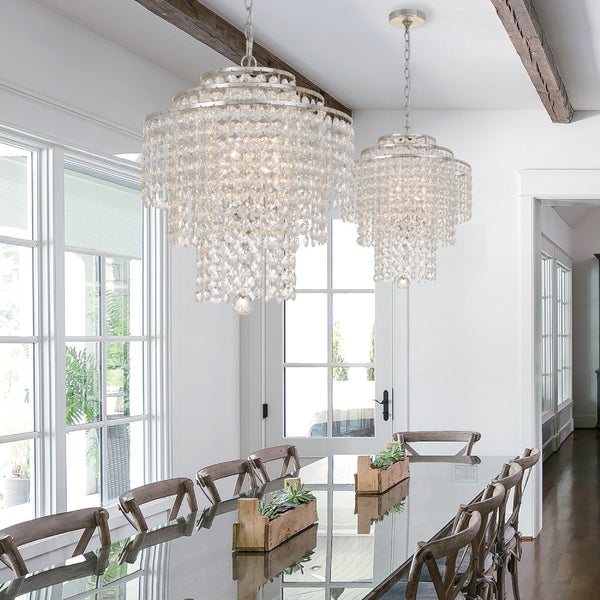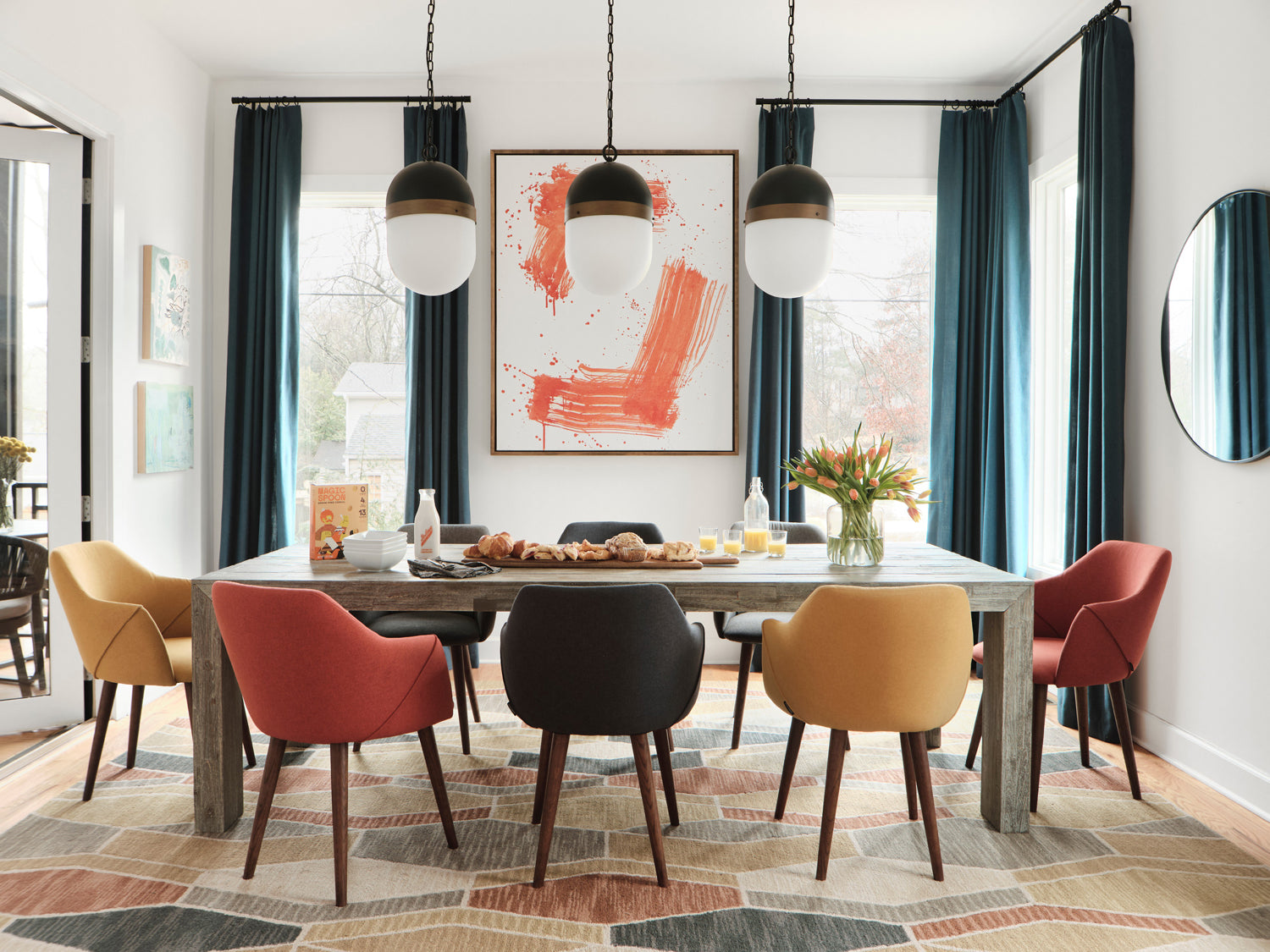What kind of light is best for a dining room?
The best kind of light for a dining room is a harmonious blend of ambient and task lighting, typically achieved through a central statement piece like a chandelier or pendant lights. These fixtures should be chosen based on the size and style of the room – a grand chandelier can add elegance to spacious dining areas, while sleek pendant lights might suit more compact or modern spaces. The lighting should hang at a height that illuminates the dining table without overpowering the space or causing glare, creating a warm and inviting atmosphere. Additionally, incorporating dimmer switches allows for adjustable lighting, perfect for setting the mood for different occasions, from intimate dinners to lively social gatherings. Accent lighting, such as wall sconces or buffet lamps, can further enhance the ambiance and highlight specific features or art pieces in the dining room.
When it comes to designing a dining room, the choice of lighting is paramount. It's not just about illuminating the space; it's about setting the mood, complementing the decor, and enhancing the dining experience. So let's explore the best types of lighting for a dining room, offering insights for homeowners and aspiring interior designers.

Understanding the Role of Lighting in Dining Rooms
The dining room is a place of gathering, celebration, and intimacy. The right lighting can transform this space, making it warm and inviting or formal and dramatic, depending on the occasion and your personal style.
Ambient Lighting: Setting the Base
Ambient lighting provides the general illumination of the dining room. It's the foundational layer that sets the overall tone of the space.
-
Chandeliers and Pendant Lights: These are classic choices for a dining room. Positioned above the dining table, they act as a focal point and provide even, overhead lighting. A chandelier adds a touch of elegance and formality, while pendant lights can offer a more modern, streamlined look.
-
Recessed or Ceiling Lights: For a more subtle approach, recessed lighting or flush-mount fixtures can offer a clean, modern feel, providing broad illumination without taking attention away from other design elements.
Task Lighting: Enhancing Functionality
While less common in dining rooms, task lighting can be practical in buffet areas or serving stations.
-
Under-Cabinet Lights: If you have cabinetry or shelving in your dining room, under-cabinet lighting can illuminate work surfaces, making it easier to prepare or serve food.
Accent Lighting: Creating Atmosphere
Accent lighting adds depth and dimension to the dining room, highlighting architectural features or artwork.
-
Wall Sconces: These wall lights can be used to light up a buffet or sideboard or to frame a piece of art, adding layers of light to the room.
-
Dimmable Lights: Installing dimmers on your dining room lights can significantly enhance the ambiance. They allow you to adjust the lighting to suit different moods and occasions – brighter for family dinners and softer for romantic evenings.

Choosing the Right Light for Your Dining Room
Selecting the perfect lighting fixture for your dining room is more than a practical decision; it's a crucial element of the room's overall design and ambiance. The right lighting not only illuminates the space but also enhances the dining experience, complementing the aesthetics and setting the mood. Here’s a deeper look at how to choose the ideal lighting for your dining room.
Assessing Room Size and Table Dimensions
The size of your dining room and the dimensions of your dining table are pivotal factors in choosing the right light fixture.
-
Large Dining Rooms: In spacious rooms, consider grand chandeliers or large-scale pendant lights that fill the space without overwhelming it. For example, a long, rectangular table might be best complemented by a linear chandelier or a series of pendants aligned down the center, providing balanced lighting and a striking visual element.
-
Compact Spaces: Smaller dining areas benefit from more proportionate lighting choices. A single, elegant pendant light or a small chandelier can offer sufficient illumination while maintaining a sense of openness and airiness in the room.
Complementing the Dining Room's Decor
The style of the lighting fixture should harmonize with the dining room’s decor, whether it's modern, traditional, rustic, or eclectic.
-
Modern Decor: Sleek pendant lights with clean lines or minimalist chandeliers can enhance a contemporary dining space, adding sophistication without overpowering the room’s modern elements.
-
Traditional Settings: Ornate chandeliers with intricate details and warm materials like brass or crystal can add a touch of timeless elegance, perfectly suiting classic interior styles.
Creating the Desired Ambiance
The lighting should create an atmosphere that resonates with your personal style and the purpose of the space.
-
Visualize Intimate Dinners: For a cozy, intimate setting, consider softer, warmer lights that cast a gentle glow over the table, enhancing the warmth and closeness of shared meals.
-
Envision Lively Gatherings: For spaces that host lively social gatherings, brighter lights that evenly illuminate the entire table can foster an inviting and energetic atmosphere.
Balancing Form and Function
The chosen light fixture should not only be a decorative piece but also functional, providing adequate lighting for the space.
-
Adjustable Lighting: Consider fixtures with adjustable heights or dimmable options. Being able to modify the light intensity or height can adapt the lighting to different occasions, whether it’s a casual brunch or an elegant dinner party.
-
Glare-Free Illumination: Ensure the light is pleasant and glare-free. Diffused light fixtures or those with shades can soften the light, reducing harshness and creating a more comfortable dining environment.
Installation and Practical Considerations
-
Ceiling Height: Factor in your ceiling height when selecting a fixture. There should be ample clearance above the dining table and around the room, maintaining both aesthetic appeal and practical functionality.
-
Professional Installation: For large or complex fixtures, professional installation may be necessary to ensure safety and optimal placement.

Conclusion
In the end, the best light for a dining room is one that provides balanced ambient illumination, complements the room's decor, and creates the desired mood and atmosphere. Whether you opt for a grand chandelier, sleek pendant lights, or subtle recessed lighting, the key is to choose a fixture that reflects your personal style and meets the functional needs of your dining space. With thoughtful consideration, your dining room lighting can transform meals into memorable experiences.
Helpful Links:
Why You should Hire a Professional Lighting Installer
Discover our collection of Dining Room Lighting fixtures




Leave a comment